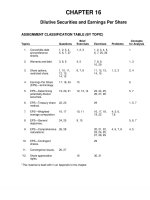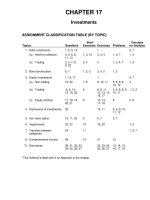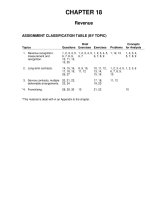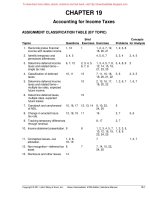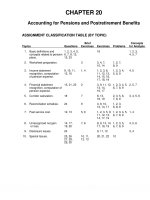Intermediate accounting IFRS 3rd ch24
Bạn đang xem bản rút gọn của tài liệu. Xem và tải ngay bản đầy đủ của tài liệu tại đây (2.19 MB, 69 trang )
Prepared by
Coby Harmon
University of California, Santa Barbara
Westmont College
24-1
CHAPTER 24
Presentation and Disclosure in
Financial Reporting
LEARNING OBJECTIVES
After studying this chapter, you should be able to:
1. Describe the full disclosure principle
and how it is implemented.
2. Discuss the disclosure
requirements for related-party
transactions, subsequent events,
major business segments, and
interim reporting.
24-2
3. Identify the major disclosures in
the auditor’s report and
management’s responsibilities
for the financial statements.
4. Describe other reporting issues
related to implementation of the
full disclosure principle.
PREVIEW OF CHAPTER 24
24-3
Intermediate Accounting
IFRS 3rd Edition
Kieso ● Weygandt ● Warfield
Full Disclosure Principle
LEARNING OBJECTIVE 1
Describe the full disclosure
principle and how it is
implemented.
Full disclosure principle calls for financial reporting of any
financial facts significant enough to influence the
judgment of an informed reader.
Financial disasters at Mahindra Satyam (IND) and Société
Générale (FRA) highlight the difficulty of implementing the full
disclosure principle.
24-4
LO 1
Full Disclosure Principle
ILLUSTRATION 24.1
Types of Financial Information
24-5
LO 1
Full Disclosure Principle
Increase in Reporting Requirements
Reasons:
24-6
Complexity of the business
environment.
Necessity for timely information.
Accounting as a control and
monitoring device.
LO 1
Full Disclosure Principle
Differential Disclosure
IASB has developed IFRS for small- and medium-sized entities
(SMEs). SMEs is less complex in a number of ways:
24-7
Topics not relevant for SMEs are omitted.
Allows fewer accounting policy choices.
Many principles for recognizing and measuring assets,
liabilities, revenue, and expenses are simplified.
Significantly fewer disclosures are required.
Revisions to the IFRS for SMEs will be limited to once
every three years.
LO 1
Notes to the Financial Statements
Notes are the means of amplifying or explaining the items
presented in the main body of the statements.
Accounting Policies
Companies should present a statement identifying the accounting
policies adopted (Summary of Significant Accounting Policies).
In addition, companies must:
24-8
1.
Identify judgments made in the process of applying the
accounting policies.
2.
Disclose information about assumptions made.
LO 1
Notes to the Financial Statements
Common Notes
24-9
MAJOR
DISCLOSURES
Inventory
Property, Plant, and Equipment
Creditor Claims
Equityholders’ Claims
Contingencies and Commitments
Fair Values
Deferred Taxes, Pensions, and Leases
Changes in Accounting Principles
LO 1
Disclosure Issues
LEARNING OBJECTIVE 2
Discuss the disclosure requirements for related-party transactions, subsequent
events, major business segments, and interim reporting.
Disclosure of Special Transactions or Events
24-10
Related-party transactions
►
Nature of relationship.
►
Amount of transaction and outstanding balances.
►
Provision for doubtful debts.
►
Expense recognized during the period in respect of
bad or doubtful debts due from related parties.
Errors and fraud
LO 2
Disclosure Issues
Events after the Reporting Period
(Subsequent Events)
1 - Events that provide additional
evidence about conditions that
existed at the statement of financial
position date.
24-11
ILLUSTRATION 24.4
Time Periods for
Subsequent Events
2 - Events that provide
evidence about conditions that
did not exist at the statement
of financial position date.
LO 2
Disclosure Issues
E24-2 (Subsequent Events): For each events, indicate whether a
company should (a) adjust the financial statements, (b) disclose in
notes to the financial statements, or (c) neither adjust nor disclose.
______
1.
a
Settlement of tax case at a cost considerably in excess of
the amount expected at year-end.
______
2.
c
Introduction of a new product line.
______
3.
b
Loss of assembly plant due to fire.
______
4.
b
Sale of a significant portion of the company’s assets.
______
5.
c
Retirement of the company president.
______
6.
b
Issuance of a significant number of ordinary shares.
24-12
LO 2
Disclosure Issues
E24-2 (Subsequent Events): For each events, indicate whether a
company should (a) adjust the financial statements, (b) disclose in
notes to the financial statements, or (c) neither adjust nor disclose.
______
7.
c
Loss of a significant customer.
______
8.
c
Prolonged employee strike.
______
9.
a
Material loss on a year-end receivable because of a
customer’s bankruptcy.
______
10. Hiring of a new president.
c
______
11. Settlement of prior year’s litigation against the company.
a
______
12. Merger with another company of comparable size.
b
24-13
LO 2
Reporting for Diversified Companies
Investors and investment analysts want income statement,
statement of financial position, and cash flow information on the
individual segments that compose the total income figure.
ILLUSTRATION 24.6
Segmented Income
Statement
24-14
Disclosure Issues
Objective of Reporting Segmented Information
To provide information about the different types of business
activities in which an enterprise engages and the different
economic environments in which it operates.
Meeting this objective will help users:
a) Better understand the enterprise’s performance.
b) Better assess its prospects for future net cash flows.
c) Make more informed judgments about the enterprise as a
whole.
24-15
LO 2
Disclosure Issues
Basic Principles
IFRS requires that general-purpose financial statements
include selected information on a single basis of segmentation.
A company can meet the segmented reporting objective by
providing financial statements segmented based on how the
company’s operations are managed (management
approach).
24-16
LO 2
Disclosure Issues
Identifying Operating Segments
An operating segment is a component of an enterprise:
a. That engages in business activities from which it earns
revenues and incurs expenses.
b. Whose operating results are regularly reviewed by the
company’s chief operating decision maker.
c. For which discrete financial information is available.
24-17
LO 2
Identifying Operating Segments
An operating segment is deemed significant and therefore a
reportable segment if it satisfies one or more of the following
quantitative thresholds.
1. Its revenue is 10 percent or more of the combined revenue of
all the company’s operating segments.
2. The absolute amount of its profit or loss is 10 percent or
more of the greater, in absolute amount, of (a) the combined
operating profit of all operating segments that did not incur a
loss, or (b) the combined loss of all operating segments that
did report a loss.
3. Its identifiable assets are 10 percent or more of the
combined assets of all operating segments.
24-18
LO 2
Identifying Operating Segments
In applying these tests, the company must consider two
additional factors.
1. Segment data must explain a significant portion of the
company’s business. Specifically, the segmented results
must equal or exceed 75 percent of the combined sales to
unaffiliated customers for the entire company.
2. The IASB decided that 10 is a reasonable upper limit for the
number of segments that a company must disclose.
24-19
LO 2
Identifying Operating Segments
ILLUSTRATION 24.7
Data for Different
Possible Reporting
Segments
The company would apply the respective tests as follows.
Revenue test: 10% x €2,150 = €215; C, D, and E meet this test.
24-20
LO 2
Identifying Operating Segments
ILLUSTRATION 24.7
Data for Different
Possible Reporting
Segments
The company would apply the respective tests as follows.
Operating profit (loss) test: 10% x €90 = €9
(the test is based on non-loss segments); A, C, D, and E meet this test.
24-21
LO 2
Identifying Operating Segments
ILLUSTRATION 24.7
Data for Different
Possible Reporting
Segments
The company would apply the respective tests as follows.
Identifiable assets tests: 10% x €970 = €97; C, D, and E meet this
test.
24-22
LO 2
Identifying Operating Segments
ILLUSTRATION 24.7
Data for Different
Possible Reporting
Segments
Reporting segments are therefore A, C, D, and E, assuming that
these four segments have enough sales to meet the 75 percent of
combined sales test.
24-23
LO 2
Identifying Operating Segments
ILLUSTRATION 24.7
Data for Different
Possible Reporting
Segments
75% of combined sales test: 75% x €2,150 = €1,612.50.
The sales of A, C, D, and E total €2,000 (€100 + €700 + €300 + €900);
therefore, the 75 percent test is met.
24-24
LO 2
Disclosure Issues
Measurement Principles
Accounting principles that companies use for segment
disclosure need not be the same as the principles they use
to prepare the consolidated statements.
The IASB does not require allocations of joint, common, or
company-wide costs solely for external reporting purposes.
Common costs are those incurred for the benefit of more
than one segment and whose interrelated nature prevents a
completely objective division of costs among segments.
24-25
LO 2





